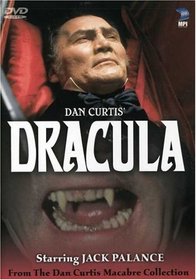| Actors: Jack Palance, Simon Ward, Nigel Davenport, Pamela Brown, Fiona Lewis Director: Dan Curtis Creators: Oswald Morris, Dan Curtis, Richard A. Harris, Robert Singer, Bram Stoker, Richard Matheson Genres: Horror, Science Fiction & Fantasy, Television, Mystery & Suspense Sub-Genres: Horror, Science Fiction & Fantasy, Television, Mystery & Suspense Studio: MPI HOME VIDEO Format: DVD - Color DVD Release Date: 08/27/2002 Original Release Date: 02/08/1974 Theatrical Release Date: 02/08/1974 Release Year: 2002 Run Time: 1hr 40min Screens: Color Number of Discs: 1 SwapaDVD Credits: 1 Total Copies: 0 Members Wishing: 3 MPAA Rating: NR (Not Rated) Languages: English |
Search - Dan Curtis' Dracula on DVD
  | Dan Curtis' Dracula Actors: Jack Palance, Simon Ward, Nigel Davenport, Pamela Brown, Fiona Lewis Director: Dan Curtis Genres: Horror, Science Fiction & Fantasy, Television, Mystery & Suspense NR 2002 1hr 40min Studio: Mpi Home Video Release Date: 08/27/2002 Run time: 111 minutes Rating: Nr |
Larger Image |
Movie DetailsSimilar Movies
Similarly Requested DVDs
|
Member Movie ReviewsReviewed on 9/17/2022... This is a great film version of Dracula. This was initially released as a 1974 British television movie.
Movie ReviewsThe consummate Dracula in Jack Palance Elizabeth G. Melillo | 11/17/2000 (5 out of 5 stars) "Jack Palance's portrayal of the eternally eerie Count makes the depiction of Dracula as a tragic figure incredibly believable. His combination of horror and pathos is brilliant in its execution - and the highly sexual attributes of the vampire legend are clear without being overdone or offensive.The excellence of this production is in its combination of intensity and restraint. Sets, for example, are not exagerrated in order to be macabre - Castle Dracula could pass for a stately home were it not for the odd inhabitants. The "completely human" characters are intelligent, refined, and normal in their actions and words - the horror of being the victims of vampires providing sufficient Gothic elements. Interestingly, this version has the rare quality of referring, however obliquely, to the real Prince Vlad, and manages to give credibility to Dracula's plight (without exploring how his vampirism came to be.)With apologies to fans of Bela Lugosi, et al, I believe Jack Palance captured the Count most perfectly." Decent Adaptation. Notable for Introducing Lovelorn Dracula. mirasreviews | McLean, VA USA | 03/04/2005 (4 out of 5 stars) "This version of "Dracula" was shown on American television in 1973, but had a theatrical release in Europe. It was adapted and directed by Dan Curtis, who changed what he felt was weak reasoning to explain why Count Dracula wants to move to England in Bram Stoker' s novel. Instead of vague ambitions of conquest in England, Curtis made Count Dracula the un-dead incarnation of the real 15th century Wallachian Prince, Vlad Tepes, who travels to England in order to be reunited with the reincarnation of his long lost love. This love storyline was inspired by the vampire television series "Dark Shadows", for which Dan Curtis was executive producer. It was borrowed by Francis Coppola and writer James Hart in Coppola's lavish 1992 film "Bram Stoker's Dracula". The story is set in the year that Bram Stoker's gothic horror novel "Dracula" was published. In 1897, an English real estate agent named Jonathan Harker (Murray Brown) arrives in the town of Bistritz, in what was then Hungary, to offer a selection of properties to a nobleman by the name of Count Dracula (Jack Palance), who plans to relocate to England. Harker finds the Count a demanding host, and Dracula proceeds to England leaving Jonathan imprisoned in his castle, terrorized by his blood-thirsty wives. Several weeks later, in the seaside town of Whitby, where Dracula's sailing ship has beached, Jonathan's fiancée, Mina (Penelope Horner) arrives to visit an ailing friend. Mina's dear friend Lucy (Fiona Lewis) has taken ill. Lucy's fiancé Arthur (Simon Ward) has called a specialist named Dr. Van Helsing (Nigel Davenport) to diagnose her. Van Helsing believes that Lucy is the victim of a vampire, an un-dead creature that sucks the blood of the living to survive, but he and Arthur are unable to protect her, and she is transformed into the living dead herself. When Dracula discovers that his new vampire bride has been destroyed, he is enraged and plans to take his revenge on Mina. This version doesn't have the emotional depth of some of the better theatrical adaptations of "Dracula". But it is not a low-rent production. We get to see the interiors of many lovely mansions. This Count Dracula is supposed to be a sympathetic monster, who wishes only to be reunited with his lady love. But he is ungracious and blunt. And Palance's expressions seem campy -nothing new in Dracula films. In contrast to the novel and most adaptations, Jonathan is absent from the major action of the film, Van Helsing is level-headed, and the vampire and his hunters confront each other directly on several occasions. Their battle isn't covert. Everyone is well aware who his enemies are. This is a solid adaptation, but not a great one. It's most notable for being the originator of the lovelorn Dracula storyline -or the romantic hero persona. 3 1/2 stars." Palance is Dracula!! charles pope | connecticut | 10/29/2001 (4 out of 5 stars) "Jack Palance gives us his rendition of the famous count and it is an excellent meoldrama. Along with Mr. Palance,s terrific acting skills he seems to move well with the cape and with no ridiculous special effects.This is more of a sympathetic Dracula , seemingly, through little fault of his own is doomed for eternity. Splendid sets and terrific editing make this film a standout. The only other abstract "Dracula" that one might find is the PBS version with Louis Jordan as the count.Atmospheric/"
|
















